Factors Affecting Wheat Yield
Despite the significant achievements of domestic scientists in the field of breeding and crop production, the influence of hydrothermal conditions on the grain productivity of winter crops remains significant. Droughts, which often occur in the Steppe zone, can affect grain filling and significantly reduce wheat yields.
Effect of weather conditions on wheat yield
Often, ground drought in the spring-summer growing season is accompanied by air drought, as a result, well-developed winter crops (winter wheat), which should provide high yields, rapidly reduce grain productivity. There is such a thing as "plant capture" - the action of adverse factors. The main sign of the capture of winter wheat plants is most often the plushness of the grain due to a violation of the water balance, when the evaporation of moisture by the plant exceeds its intake from the soil. The harmful effect of dry winds is mainly reduced to the fact that the consumption of soil moisture reserves is significantly accelerated. But the negative impact of drought can be reduced by proper provision of winter wheat crops with moisture through irrigation.
The degree of damage to crops is determined by the period of drought:
- The capture of plants during the formation of pollen adversely affects fertilization, resulting in a through-grain or even empty head.
- If the capture of bread occurs at the beginning of grain filling (before the phase of milky ripeness), the grain consists of almost only shells and contains only a small amount of starchy substance.
- If the capture of plants occurs in somewhat later periods, a plush grain is formed.
The capture of plants is accompanied by the heat of the grain, leads to a violation of its development and premature ripening in spikelets due to the negative impact of droughts, high air temperatures and, especially, hot winds - dry winds. As a result, a well-developed grain of winter wheat suddenly shrinks and becomes plush.
Seizure of grain in the Steppe zone occurs mainly in the second half of June - July.
Study of the formation of winter wheat grain yield
The aim of the work of scientists was to study the dynamics of winter wheat grain filling under various hydrothermal growing conditions, depending on the influence of agricultural practices.
The method for determining the dynamics of grain filling, which was founded by M.M. Kuleshov (subsequently improved by I. Strona and V.M. Kostromitin), is based on identifying the relationship between the specifics of growth and accumulation of dry matter in grain by successively determining the moisture content of the grain and the mass of 1000 grains.
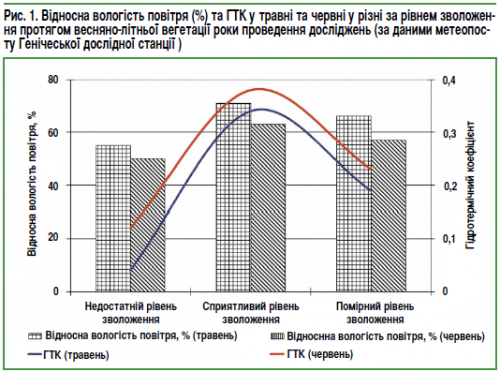
Studies on the influence of sowing dates, predecessors, seeding rates and hydrothermal conditions during the growing season of winter wheat on grain filling were carried out at the Genichesk Experimental Station of the Institute of Grain Crops (Kherson region). The Sivash zone is an arid region of Ukraine. The conditions for growing winter crops here are very harsh. This is due to the high temperature regime of air, insufficient amount of precipitation and their uneven distribution during the growing season of plants. The average long-term air temperature in the Sivash region is 10.3 ° C, the amount of precipitation is 398 mm. The soft winter wheat variety Kuyalnik was sown on black fallow and after sunflower. Sowed in three terms: 5 and 25 September and 15 October. Seeding rates were 3, 5, and 7 million germinating seeds/ha, respectively. The soil of the experimental field is dark chestnut, solonetzic to varying degrees. The content of humus in the arable layer is 2.2-2.4%, nitrogen is 0.11-0.13; phosphorus - 0.10-0.12; potassium - 0.14-0.16%. In addition to the elements that were studied in this study, the technology of growing winter wheat was generally accepted for the Southern Steppe of Ukraine.
The weather conditions during the research period were characterized by a significant contrast, which in a certain way influenced the formation and filling of grain. To establish the exact volumes of water use by plants from the soil and their moisture supply, the hydrothermal coefficient (HTC) was determined during the period of ear and grain formation. In the dry year of research, the HTC in May was the lowest - 0.04, in June - 0.12. Abnormally dry weather conditions were complicated by low relative air humidity, which was 55% in May and 50% in June (Fig. 1).
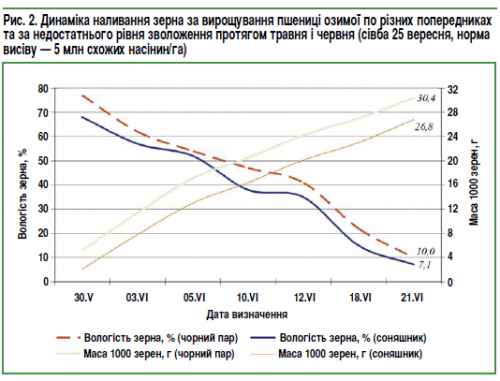
On some days, air humidity decreased to 20-30%, and sometimes even lower, which, in combination with high air temperature and strong wind, negatively affected the formation and filling of grain.
Such weather conditions led to its accelerated ripening, which further affected the yield. It is known that the amount of the substance contained in the grain and its fineness are determined by the mass of 1000 grains. And, of course, larger grains have a higher 1000-grain weight. So, in fig. 2 it can be seen that in the year with an insufficient level of moisture in May and June, the moisture content of grain rapidly decreased and already on June 21 in the sowing carried out on black fallow, it was 10, and after sunflower - 7.1%. On the other hand, the mass of 1000 grains gradually increased and reached 30.4 and 26.8 g, respectively.
Favorable moisture conditions in May and June lengthened the vegetation period of winter wheat. So, during the harvesting of grain crops (June 26), the moisture content of grain in the variants where the predecessor was black fallow was 14, and in winter crops after sunflower - 8%. The mass of 1000 grains in this case reached 35.9 and 32.8 g, respectively. So, the difference in the weight of 1000 grains of winter wheat in years with favorable moisture conditions and with an insufficient level of moisture in May and June after sowing on a black fallow was 15.3, and after sunflower - 18.3% (Fig. 3).
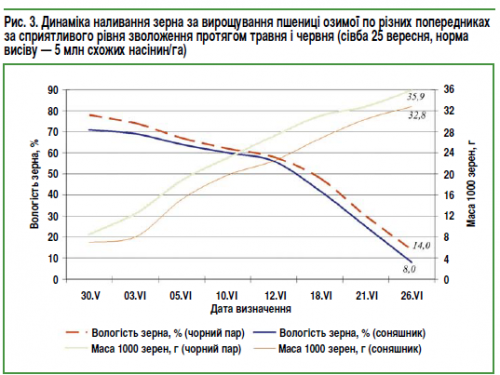
The influence of predecessors on the yield of winter wheat
An analysis of grain moisture in the cultivation of winter wheat after various predecessors indicates that in the black fallow, due to the weakening of the moisture loss of the grain, the plants were more resistant to the adverse effects of drought. In our opinion, this is due to the large reserves of moisture in the soil compared to the sowing of winter crops after the predecessor sunflower. That is, after non-steam precursors, due to water deficiency, the moisture content of the grain decreased much faster, which led to the formation of a plush grain with a low weight of 1000 grains. On fig. 2 and 3, it can be seen that the significance of the predecessor is not limited to the moisture supply of winter wheat plants in the main phases of development, but also manifests itself during the filling and ripening of the grain.
Influence of sowing dates on the yield of winter wheat
In our experiments, the grain loading dynamics and the weight of 1000 grains were influenced not only by the predecessors, but also by the sowing dates. So, when sowing winter wheat on September 5 (early term) with a seeding rate of 5 million germinating seeds / ha, the difference in weight of 1000 grains between plants in crops after sunflower and in black fallow was 3.3%, on September 25 - 7.5; October 15 - 5.6%. For each of the predecessors, the largest mass of 1000 grains was at early sowing dates, the value of this indicator gradually decreased with a shift in sowing dates towards late ones. The lowest weight of 1000 grains when sowing winter wheat in the late periods is explained by the difference in the development of such crops compared to early ones. Plants in winter wheat crops of late sowing periods, of course, began flowering, grain formation and filling later, and in this case were exposed to drought and were more intensively damaged by dry winds.
Seed sowing rates also influenced the dynamics of grain filling, since the plant density per unit area was different. In plots where the seeding rate was 3 million viable seeds/ha, grain moisture was higher compared to thicker crops. The difference in this indicator was insignificant in plots with a seeding rate of 3 and 7 million viable seeds/ha and amounted to 0.8-2.4%. Since the yield of wheat is formed due to the interaction of productivity elements, in particular the number of productive stems, the mass of grain per ear, the mass of 1000 grains, grain size significantly influenced the size and quality of the crop.
Despite the significant density of productive stems in a year with insufficient moisture during May and June, which was manifested in some areas by exceeding the corresponding indicators in a year with a favorable level of moisture in these months, the wheat yield this year was significantly lower.
In a dry year unfavorable for grain loading, wheat plants formed small seeds, the weight of which, depending on the timing and sowing rates, varied between 23.9-29.7 g when grown after sunflower and 29.1-31.7 g after the black predecessor. steam.
The effect of nutrition and fertilizer on the yield of winter wheat
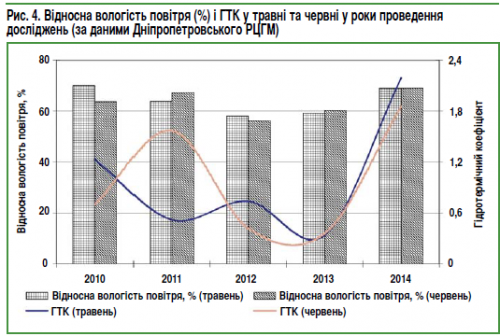
To determine the influence of the level of mineral nutrition on the dynamics of grain loading and the formation of winter wheat yields during 2010-2014, we conducted research in the experimental farm "Dnepr" of the Institute of Grain Crops (Dnepropetrovsk region). The winter wheat variety Litanivka was sown on black fallow and after the stubble predecessor. The technology of growing wheat in the experiments was generally accepted for the northern part of the Steppe. The studies were carried out in two versions: without fertilization (control) and with the introduction of background fertilizer N60P60K60 - after sunflower and N30P30K30 (background) - for black fallow; background + N30 on permafrost soil (MTG) + N30 in the tillering phase of plants in the spring by spraying (the concentration of the working solution is 9.5%). Nitrogen fertilizers were applied in the form of UAN - carbamide-ammonia mixture.
The determination of the hydrothermal coefficient in May and June showed that the growing conditions in the experimental farm were more favorable than in the Sivash region. Low HTC values in May and June were noted in 2013 - 0.34 and 0.36, respectively. 2014 was favorable in terms of humidification: HTC in May was 2.19, in June - 1.85, and the average monthly relative humidity was high - 69% (Fig. 4).
At the same time, despite the relatively high average monthly values of relative air humidity over the years of research, dry winds often occurred during the grain filling period. The year 2012 was characterized by low relative air humidity, in May the value of this indicator was 58, and in June - 56.3%.
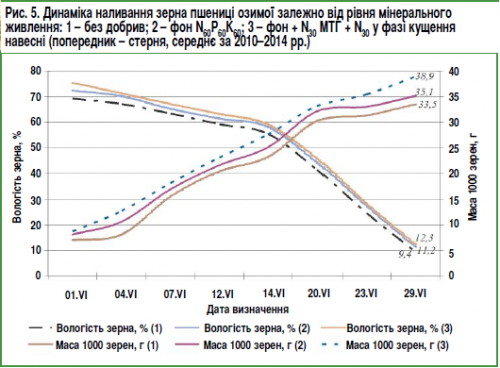
According to the results of the research, it was found that when growing winter crops after stubble predecessors in the control variant, the wheat yield decreased more intensively, which was due to low grain moisture and the formation of the lowest mass of 1000 grains. On average, in 2010-2014, the weight of 1000 grains in these areas was 33.5 g (Fig. 5).
In the plots with the introduction of background fertilizer N60P60K60, the weight of 1000 grains reached 35.1 g, and for N60P60K60 with subsequent feeding of N30 according to MTG and N30 in the tillering phase in spring - 38.9 g.
Grain moisture decreased less intensively in variants with a high level of mineral nutrition. So, as of June 29, the grain moisture in these variants was 12.3%, while in the areas with the application of only the background fertilizer N60P60K60 - 11.2, and without the application of fertilizers - 9.4% (Fig. 5). In our opinion, this is due to the fact that the application of mineral fertilizers has activated the growth processes in plants, and with a more favorable nutritional regimen, the duration of the growing season of winter wheat increases.
Due to the better moisture supply of winter crops on black fallow, the intensity of winter wheat grain filling increased compared to areas where winter crops were grown after sunflower, however, the decrease in grain moisture content was slower. So, on average for 2010-2014, the weight of 1000 grains as of June 29 in the variants with the introduction of the background mineral fertilizer N30P30K30 was 38.4 g, and the grain moisture content was 11.2%. After additional feeding of crops with nitrogen, an increase in the mass of 1000 grains to 40.8 g and a decrease in grain moisture content to 13.9% were observed. The minimum values of the weight of 1000 grains (36.2 g) and grain moisture content (11.2%) were in the control variant - without the application of mineral fertilizers (Fig. 6).
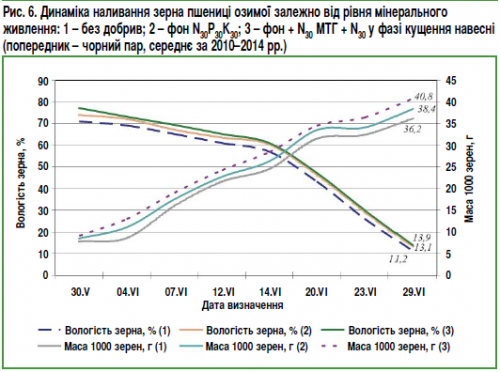
Based on the analysis of the level of moisture loss by winter wheat caryopsis per day, it was found that on moderate-temperature days, grain moisture during ripening decreased by 1.0-1.5%, and in the event of dry winds on some days, by 2.0 -3.0%.
Thus, winter wheat, sown on a black fallow and sufficiently provided with mineral nutrients, turned out to be more resistant to dry conditions during the period of grain filling. The accumulation of dry matter in the grain and, accordingly, the growth in the weight of 1000 grains in such crops were characterized by high rates compared to winter crops, which were sown after non-fallow predecessors.
Under the conditions of the current year, the level of moisture supply for winter wheat plants during the spring period was very favorable. Therefore, there are good reasons for this production season's high yield of winter wheat grain. So, the examples given in this article convincingly indicate that the level of grain productivity of winter crops directly depends on the hydrothermal conditions during the formation and filling of grain. The reserves of productive moisture in the soil in most of the Steppe zone are quite high, which prevents a decrease in the yield of winter wheat due to ground drought. The risk of reducing the yield of winter crops can only be the possible occurrence of dry winds during the period of grain filling.
A. Zhelyazkov, cand. Agricultural Sciences, Institute of Grain Crops NAAS

